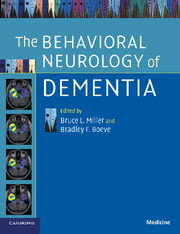Book contents
- Frontmatter
- Contents
- List of contributors
- Section 1 Introduction
- Section 2 Cognitive impairment, not demented
- Section 3 Slowly progressive dementias
- 18 Semantic dementia
- 19 Progressive non-fluent aphasia
- 20 Cognition in corticobasal degeneration and progressive supranuclear palsy
- 21 Cognitive and behavioral abnormalities of vascular dementia
- 22 CADASIL: a genetic model of arteriolar degeneration, white matter injury and dementia in later life
- Section 4 Rapidly progressive dementias
- Index
- References
19 - Progressive non-fluent aphasia
Published online by Cambridge University Press: 31 July 2009
- Frontmatter
- Contents
- List of contributors
- Section 1 Introduction
- Section 2 Cognitive impairment, not demented
- Section 3 Slowly progressive dementias
- 18 Semantic dementia
- 19 Progressive non-fluent aphasia
- 20 Cognition in corticobasal degeneration and progressive supranuclear palsy
- 21 Cognitive and behavioral abnormalities of vascular dementia
- 22 CADASIL: a genetic model of arteriolar degeneration, white matter injury and dementia in later life
- Section 4 Rapidly progressive dementias
- Index
- References
Summary
Introduction
Aphasia has long been recognized as a common language disorder typically resulting from acute left hemisphere lesions, often caused by strokes. A progressive form of aphasia was first described over a century ago by Arnold Pick, the famed Prague neurologist, who detailed the language deficits in his initial group of patients (Pick 1892). The modern term, progressive aphasia, was introduced by Marsel Mesulam in 1982 in a landmark paper in which he described six patients who presented with language deficits in the absence of other behavioral abnormalities. This progressive disorder was clinically distinct from other dementing processes, such as Alzheimer's disease (AD), because language complaints, rather than memory problems, were the most salient symptoms. Speech or language deficits remained the only impairment for the first 2 years in these patients, but as the disease progressed more generalized states of dementia became apparent.
Since then, numerous cases of what is now termed primary progressive aphasia (PPA) have been described, in which patients present with both fluent and non-fluent variants of the disorder (Deleceuse et al., 1990; Weintraub et al., 1990; Snowden et al., 1992, 1996; Mesulam 2001; Gorno-Tempini et al., 2004a). The non-fluent variant, known as progressive non-fluent aphasia (PNFA), is important clinically because speech problems are often the first symptoms of neurodegenerative diseases, such as frontotemporal lobar dementia (FTLD) and corticobasal degeneration (CBD) (Tyrrell et al., 1991; Broussolle et al., 1996; Chapman et al., 1997; Gorno-Tempini et al., 2004b).
- Type
- Chapter
- Information
- The Behavioral Neurology of Dementia , pp. 279 - 287Publisher: Cambridge University PressPrint publication year: 2009



